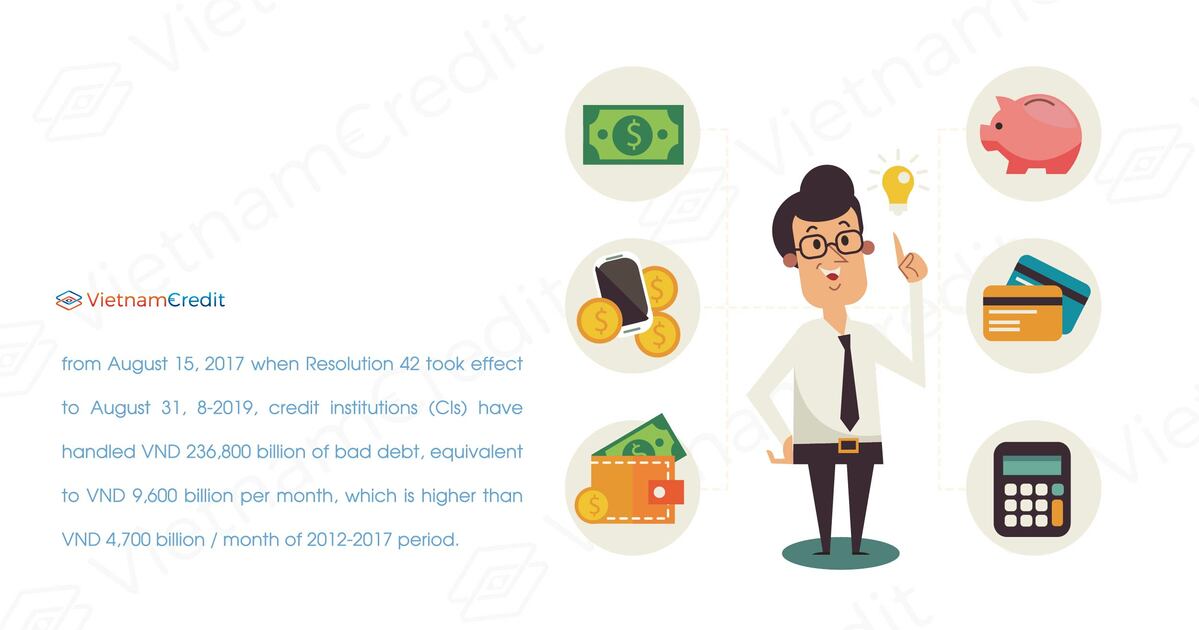Nine-month financial statements of many banks showed that the absolute non-performing loans (NPLs) continued to increase compared to the beginning of the year, although the NPL ratio decreased due to the faster increase in outstanding loans. This implies two possibilities: the new NPLs are still arising or the handling of NPL has slowed down, or due to both of the above reasons
Slow handling increases NPLs?
At the two-year preliminary online conference on the implementation of National Assembly Resolution No. 42 on pilot bad debt handling, it was reported that from August 15, 2017 when Resolution 42 took effect to August 31, 8-2019, credit institutions (CIs) have handled VND 236,800 billion of bad debt, equivalent to VND 9,600 billion per month, which is higher than VND 4,700 billion / month of 2012-2017 period.
At the one-year preliminary meeting in August last year, the amount of NPLs handled from August 15, 2017 to June 30, 2018 was nearly VND 138,300 billion, which is an average VND 13,800 billion / month. Thus, the amount of NPLs further handled in the past 14 months indicates that the rate of NPL handling seems to be slowing down.

This slowing trend is also reflected in the NPL data of banks, when the nine-month financial statements of many banks showed that the absolute NPLs continued to increase compared to the beginning of the year, despite the fact that NPL ratio decreased due to faster increase in loan balance.
For example,
VietA Bank’s NPLs was VND 481 billion as of September 30, an increase of VND 38 billion compared to the end of 2018.
VIB experienced a decrease from 2.52% to 2.04% in NPL ratio, but in absolute terms, the ratio in the balance sheet increased by 4% to VND 2,517 billion. NPLs of
BacA Bank was VND 504 billion as of September 30, increasing by about VND 15 billion from the beginning of the year.
It is noteworthy that
ABBank's NPLs in the balance sheet suddenly increased by 79% to VND 1,766 billion, which means the NPL ratio to outstanding loan increased from 1.89% at the beginning of the period to 3.39%.
Although no data on NPLs of
NCB has been disclosed, in the first nine months of the year, this bank has deducted VND 33 billion for risk provision expenses and VND 70 billion for settlements under the bank restructuring project, which is VND 9 billion higher than the same period last year. Though
Saigon Bank's NPLs on the balance sheet was VND 294 billion, down VND 7 billion compared to the beginning of the year, Group 5 debt accounted for 72% of the total NPLs.
MBBank also recorded Group 5 debt with a non-performing loan ratio of 1.35%, up from 1.22% at the end of last year. In absolute terms, the increase was VND 577 billion, equivalent to 23%, mainly due to the increase of over VND 386 billion in debt of Group 5, equivalent to an increase of 40.3% to VND 1,345 billion.
Overall, some banks have not only witnessed the increase in NPLs but also the fluctuation of bad debt structure in a more negative trend, with Group 5 debt increasing sharply. In fact, the absolute amount of NPLs of many banks increased not only in the first nine months but also in 2018 and the first six months of this year. After causing a surprise with a total increase of VND 911 billion in NPLs in the first six months of this year, the newly released third-quarter data of
Vietcombank showed that the bank's non-performing loan continued to increase by VND 491 billion, contributing to the increase to VND 1,402 billion of NPLs in nine months, of which Group 3 debt increased by VND 498 billion, equivalent to 3.2 times.
Problems
While businesses still face many difficulties and the real estate market is not as vibrant as before, it is understandable for banks to slowly handle NPLs, especially when the size of outstanding loans has increased sharply over the years, negatively impacting the NPL ratio of the banking system.
Specifically, according to the latest report, the NPL ratio of the CI system continues to remain below 2%. If including the bad debts sold to
Vietnam Asset Management Company (VAMC) and bad-debts-to-be debts, NPL ratio was 4.84% as of the end of August 2019, down from 7.36% in 2017 and 5.85% in 2018.
However, this may be due to the increase in the size of outstanding loans over the past three years. Specifically, credit growth in 2017 was more than 18%, 14% in 2018 and 9.4% in the first nine months of this year, which means after nearly three years, the credit scale increased by approximately VND 2.38 million billion.
Therefore, except for banks in the restructuring process that still have to focus on recovering bad debts to accelerate the recovery process, other banks seem to be negligent in solving and recovering bad debts like they did before. Accordingly, banks that have brought the NPL ratio to below the safe level of 3% are focusing resources on other business activities that are expected to be more effective in current fierce competition.
In addition, bad debts with good collateral and are easy to handle have already been recovered. The rest are the "hardest" and the most difficult ones, which take a lot of time. There are a lot of assets that are too large and no one is able to buy due to limited financial resources, especially when the debt trading market in Vietnam has not yet been fully formed and has not attracted foreign investors.
Although Resolution 42 was said to provide breakthrough solutions, when it is implemented, it reveals a number of issues, such as regulations on collateral security, judgment execution, and inconsistent tax mechanism in localities. The application of the shortened procedure is not as smooth as expected, yet has many obstacles and the number of successful deployments is limited.
For example, the right to seize collateral of credit institutions comes with the condition that mortgage documents must include seizure terms. However, in fact, by the time Resolution 42 came into effect, many Mortgage contracts had not had this clause yet. Therefore, credit institutions need to renegotiate with debtors to adjust contracts or sign loan appendix. Meanwhile, the seizure of collateral assets of credit institutions still requires the support of the police agencies at all levels as there are many cases where the guarantor opposes and does not cooperate, CIs do not know how to enforce.
Another limitation is the overlapping provisions of the legal documents, such as the handling of security assets as real estate projects under Resolution 42 face difficulties because of not complying with the provisions of law regarding the handling of security assets. CIs and transferors must also comply with the provisions of the law on investment. When it comes to the stage of enforcement of property distraint and auction in dealing with disputes, parties may violate the Law on Execution of Criminal judgments.
























































